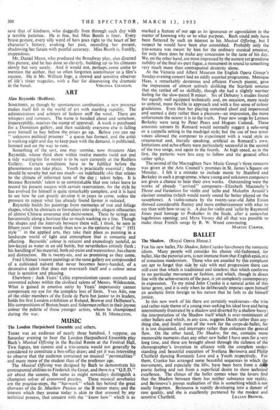ART Alan Reynolds (Redfern).
SOMETIMES, as though by spontaneous combustion, a new presence makes itself felt in the world of art with startling rapidity. The administrators and arbiters of fashion sniff the wind. There are whispers and rumours. The name is bandied about and somehow, Imperceptibly, receives the stamp of approval. A work is purchased for a Dominion gallery, and then suddenly everyone else is falling over himself to buy before the prices go up. Before you can say "unknown political prisoner" a queue has formed, and the artist is working night and day to keep pace with the demand, is publicised, lionised and on the way to ruin.
Something of the sort, one may surmise, now threatens Alan Reynolds, whose third show within twelve months (sold out and a tidy waiting-list for more) is to be seen currently at the Redfem Gallery. Certain conditions have to be fulfilled before the phenomenon can take place. Youth is practically essential ; there should be novelty but not too much—an indefinable chic that relates to the climate of informed taste of the day ; talent helps. It is because Reynolds' talent is so unmistakable that one takes leave to record his present success with certain reservations, for the style he has evolved for himself is quite remarkably complete, and it is hard to see how he can greatly develop it in years to come, unless the pressure to repeat what has already found favour is reduced.
Reynolds builds his paintings from memories of tree and foliage shapes, which he abstracts or formalises into spiky, elegant silhouettes of almost Chinese assurance and decisiveness. These he strings out horizontally along a horizon like so much washing on a line. Though the shapes and the intervals between them will, I think, be seen in fifteen years' time more easily than now as the epitome of the" 1951 style" in the applied arts, they take their place as painting in a landscape world of light and atmosphere that is romantic and affecting. Reynolds' colour is reticent and exceedingly tasteful, as low-keyed as water in an old bottle, but nevertheless entirely fresh • his handling of his material, both oil-paint and watercolour, has charmi and distinction. He is twenty-six, and as promising as they come.
Fred Uhlman 's recent paintings at the same gallery are compounded of a cultivated naiveté that never becomes heavy-handed, of a decorative talent that does not overreach itself and a colour sense that is sensitive and pleasing.
Elsewhere : Jack Yeats' Celtic expressionism causes uncouth and unwonted echoes within the civilised salons of Messrs. Wildenstein. What is gained in emotive unity by Yeats' impetuosity cannot compensate my eye for the complete loss of form. Yves Alix, one of the older members of the Ecole de Paris but junior to its leaders, holds his first London exhibition at Roland, Browse and Delbanco's. His compositions of Breton boats and fishermen reflect in their joyous colour the palette of those younger artists, whom he championed


































 Previous page
Previous page